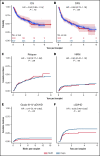HLA-matching with PTCy: a reanalysis of a CIBMTR dataset with propensity score matching and donor age
- PMID: 35613462
- PMCID: PMC9327541
- DOI: 10.1182/bloodadvances.2022007741
HLA-matching with PTCy: a reanalysis of a CIBMTR dataset with propensity score matching and donor age
Abstract
Blood or marrow transplantation (BMT) outcomes using haploidentical donors (Haplo) and posttransplant cyclophosphamide (PTCy)-based graft-versus-host disease (GVHD) prophylaxis compare favorably to HLA-matched donors using calcineurin inhibitor-based prophylaxis. A recent Center for International Blood and Marrow Transplant Research analysis of patients receiving homogenous PTCy-based prophylaxis found that, with reduced intensity conditioning, Haplo BMTs had worse outcomes than matched unrelated donor (MUD) BMTs. Due to significant differences between groups, we reanalyzed the dataset using propensity score matching and, additionally, added a donor age variable. After matching MUD BMTs to Haplo BMTs in a 1:5 ratio, no significant differences were found between groups across all measured baseline characteristics. Outcomes analyses demonstrated no significant differences in overall survival (hazard ratio [HR] of mortality with MUD vs Haplo [95% confidence interval], 0.95 [0.65-1.16], P = .75), disease-free survival (HR of relapse or death, 0.98 [0.73-1.18], P = .89), relapse rate (HR, 1.06 [0.77-1.38], P = .69), or nonrelapse mortality (NRM) (HR, 0.85 [0.42-1.13], P = .49) between groups. After stratification by conditioning intensity, MUD BMTs in the reduced-intensity cohort had lower risk of NRM (HR, 0.56 [0.14-0.99], P = .05), with no significant difference in other clinical outcomes. These results suggest the effect of HLA matching on BMT outcomes with PTCy is less meaningful than previously reported. Timely identification of a young, at least half-matched (related or unrelated) donor may be more important than finding a fully matched donor if the latter leads to a delay in BMT or use of an older donor.
© 2022 by The American Society of Hematology. Licensed under Creative Commons Attribution-NonCommercial-NoDerivatives 4.0 International (CC BY-NC-ND 4.0), permitting only noncommercial, nonderivative use with attribution. All other rights reserved.
Figures





Similar articles
-
HLA-haploidentical vs matched unrelated donor transplants with posttransplant cyclophosphamide-based prophylaxis.Blood. 2021 Jul 22;138(3):273-282. doi: 10.1182/blood.2021011281. Blood. 2021. PMID: 34292325 Free PMC article.
-
Haploidentical Versus Matched Unrelated Donor Transplants Using Post-Transplantation Cyclophosphamide for Lymphomas.Transplant Cell Ther. 2023 Mar;29(3):184.e1-184.e9. doi: 10.1016/j.jtct.2022.11.028. Epub 2022 Dec 25. Transplant Cell Ther. 2023. PMID: 36577482 Free PMC article.
-
Transplant outcomes using older matched sibling donors compared with young alternative donors: a CIBMTR analysis.Blood Adv. 2025 Jul 22;9(14):3469-3478. doi: 10.1182/bloodadvances.2024014858. Blood Adv. 2025. PMID: 40048743 Free PMC article.
-
Posttransplant cyclophosphamide beyond haploidentical transplantation.Ann Hematol. 2024 May;103(5):1483-1491. doi: 10.1007/s00277-023-05300-8. Epub 2023 Jun 1. Ann Hematol. 2024. PMID: 37261557 Review.
-
Comparable Outcomes for Hematologic Malignancies after HLA-Haploidentical Transplantation with Posttransplantation Cyclophosphamide and HLA-Matched Transplantation.Adv Hematol. 2015;2015:431923. doi: 10.1155/2015/431923. Epub 2015 Dec 2. Adv Hematol. 2015. PMID: 26713094 Free PMC article. Review.
Cited by
-
Early cessation of calcineurin inhibitors is feasible post-haploidentical blood stem cell transplant: the ANZHIT 1 study.Blood Adv. 2023 Sep 26;7(18):5554-5565. doi: 10.1182/bloodadvances.2023009840. Blood Adv. 2023. PMID: 37467011 Free PMC article. Clinical Trial.
-
Donor types and outcomes of transplantation in myelofibrosis: a CIBMTR study.Blood Adv. 2024 Aug 27;8(16):4281-4293. doi: 10.1182/bloodadvances.2024013451. Blood Adv. 2024. PMID: 38916866 Free PMC article.
-
CAST Regimen for GvHD Prophylaxis: A CIBMTR Propensity Score-Matched Analysis.Transplant Cell Ther. 2024 Nov;30(11):1092-1098. doi: 10.1016/j.jtct.2024.08.015. Epub 2024 Aug 30. Transplant Cell Ther. 2024. PMID: 39209024
-
In search of the perfect donor: youth must be served.Blood Adv. 2025 Jul 22;9(14):3540-3542. doi: 10.1182/bloodadvances.2025016207. Blood Adv. 2025. PMID: 40638130 Free PMC article. No abstract available.
-
Haploidentical stem cell donor choice for patients with acute myeloid leukemia: a study from the ALWP of the EBMT.Blood Adv. 2024 May 28;8(10):2332-2341. doi: 10.1182/bloodadvances.2023012133. Blood Adv. 2024. PMID: 38429091 Free PMC article.
References
-
- Martínez C, Gayoso J, Canals C, et al. ; Lymphoma Working Party of the European Group for Blood and Marrow Transplantation . Post-transplantation cyclophosphamide-based haploidentical transplantation as alternative to matched sibling or unrelated donor transplantation for Hodgkin lymphoma: a registry study of the Lymphoma Working Party of the European Society for Blood and Marrow Transplantation. J Clin Oncol. 2017;35(30):3425-3432. - PubMed
-
- Ahmed S, Kanakry JA, Ahn KW, et al. . Lower graft-versus-host disease and relapse risk in post-transplant cyclophosphamide-based haploidentical versus matched sibling donor reduced-intensity conditioning transplant for Hodgkin lymphoma. Biol Blood Marrow Transplant. 2019;25(9): 1859-1868. - PMC - PubMed
Publication types
MeSH terms
Substances
Grants and funding
LinkOut - more resources
Full Text Sources
Research Materials

